Mudlarking: Searching for Lost Treasure – and History – on the Banks of the Thames
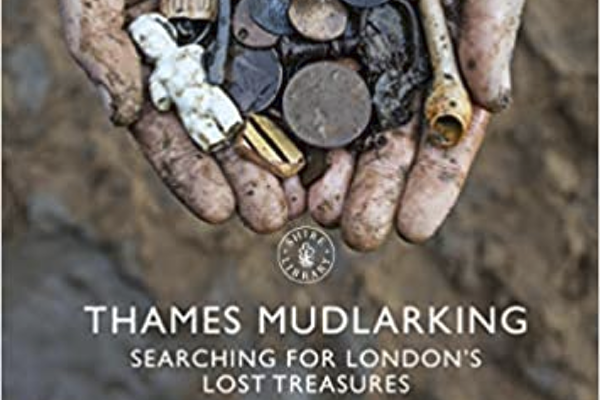
Ever since man first quenched his thirst in its waters, he has left his mark on the riverbed.
Ivor Noël Hume, Treasure in the Thames (1956)
London would not exist without the River Thames. It is a source of fresh water and food, a path of communication and transportation, and acts as a real and imaginary boundary. More importantly, it facilitates trade using the incoming and outgoing tides that has made London such a functional and successful port.
Since the beginning of time, the River Thames in London has been a great repository, collecting everything that has been deposited into its waters. Once discovered, these objects reveal stories of the capital’s fascinating history and its inhabitants.
Established by the Romans in the 1st century AD, the edge of the river has always been a hive of activity. Merchants, boat builders, sailors, fishermen and even passengers crossing the Thames would have kept the riverside busy around the clock. Lightermen and Stevedores (quayside laborers) would have worked tirelessly loading and unloading ships’ cargo and transporting imported goods to warehouses along the river front. Local traders, shops and taverns would have been packed into the adjacent streets and lanes, providing materials and refreshments for those thriving industries and their employees.
There are many reasons why objects were deposited or accidentally lost in the river. For instance, the earliest settlers deposited votive offerings in to the Thames as they considered the waters to be sacred. Celtic tribes also deposited valuable, highly decorated military items in the Thames. In the Medieval period, pilgrims returning from their long journeys abroad or pilgrimages in Britain would cast their pewter souvenir badges into the river to express their gratitude for safe passage on their journey. Today, the Hindu community living in London considers the Thames to a replacement for the holy Ganges River in India and deposit a wide variety of colorful offerings into the river.
The dense, silty Thames mud is “anaerobic,” meaning oxygen is absent. When objects are dropped into the mud, the turbulent current of the incoming tide quickly buries the object in the dense, black silt. Without oxygen, the objects are preserved in the condition in which they are dropped into the Thames. Sometimes objects are found that are perfectly preserved after many years in the river.
It is through all of these objects that we can discover and understand London’s rich history and its inhabitants who have lived along the river, from prehistoric man to modern Londoners in the 21st century.
Early historians and archaeologists first realized the historical importance of the River Thames through dredging works carried out during the 19th century. Some of the most significant and historically important artifacts were discovered during this time including the Battersea Shield (Celtic), Waterloo Helmet (Celtic), and bronze head of Emperor Hadrian (Roman). Thomas Layton, Charles Roach Smith and G. F. Lawrence were antiquarians in London who collected valuable and historically important artifacts that were dredged from the river in the 19th century. Many of their most significant finds are now on display in London’s museums. The term “Mudlark” was first used during the 18th century and was the name given to people literally scavenging for things on the riverbank. These original mudlarks were often children, mostly boys, who would earn a few pennies selling items like coal, nails, and rope that they found in the mud at low tide.
Today’s mudlark is different from those poor wretches of the 1700s. Instead of mudlarking to survive, mudlarks today have a passionate interest in London’s rich archaeology and history. Equipped with a mandatory license, mudlarks use a variety of methods to search the foreshore and have discovered and recovered an incredibly wide range of artifacts.
In 1980, the Society of Thames Mudlarks and Antiquarians was formed and were granted a special mudlarking licence from the Port of London Authority. They work very closely with the Museum of London and the Portable Antiquities Scheme (PAS), where their finds are recorded.
Over the last 40 years, mudlarks have made a really important contribution to the study of London’s history through the sheer volume and variety of finds that they have discovered. Numerous toys, like miniature plates and urns, knights on horseback and toy soldiers have actually changed the way historians view the medieval period. Made mainly from pewter, these medieval toys are exceptionally rare and have helped transform perceptions of childhood during the Middle Ages. The museum has acquired tens of thousands of mudlarking finds recovered from the River Thames foreshore, which is the longest archaeological site in Britain. Many of the most significant mudlark discoveries are on permanent display in the Museum of London and other museums in London.
Mudlarking has now become a popular hobby that gives both adults and children a unique “hands on history” experience and deepens their understanding of London’s past. The Thames Museum Trust, established in 2015, is currently developing a new museum in London to showcase a wide variety of amazing artifacts from the mudlarking community’s private collections. Exhibitions and lectures at the Tate Modern, the Bargehouse at the Oxo Tower, and the Art Hub Studios were extremely popular events.
Mudlarks Jason Sandy and Nick Stevens have combined their writing and photography skills to produce a new publication for Shire Books. With contributions from more than 50 mudlarks and accompanied by over 160 color photographs, this fascinating book tells the story of London using extraordinary mudlarking discoveries.
Written chronologically, the book begins with prehistory and takes the reader on an epic journey through time. From historically significant masterpieces, such as the Battersea Shield and Waterloo Helmet, to personal items including dress and fashion accessories, children’s toys and religious artefacts. Each object reveals a unique story and offers us a tantalizing glimpse into the past. This book brings them back to life, often uncovering new and important information about London’s history.

Early Bronze Age Flint Arrowhead. This delicate, barbed and tanged flint arrowhead has survived in exactly the same condition as when it was made approximately 4500 years ago. Finder and image: Tony Thira
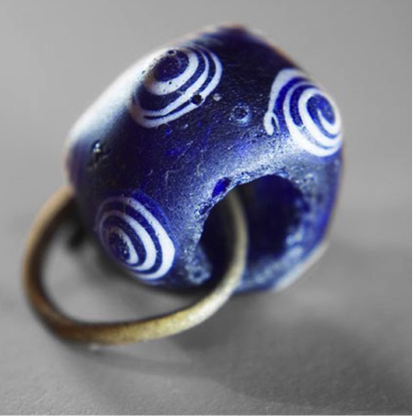
Iron Age Bead 800-100 BC. Of the 50 or so known examples of this type, this is the only one that has been found attached to a metal ring.
Finder: John Higginbotham Image: Nick Stevens
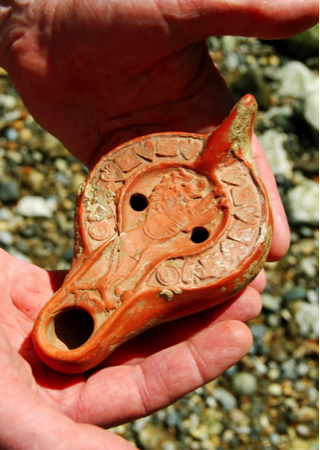
Roman Oil Lamp A rare example of a North African ceramic oil lamp depicting a running lion symbolising Christianity. AD 300–410 Finder: Alan Suttie, Image: Stuart Wyatt
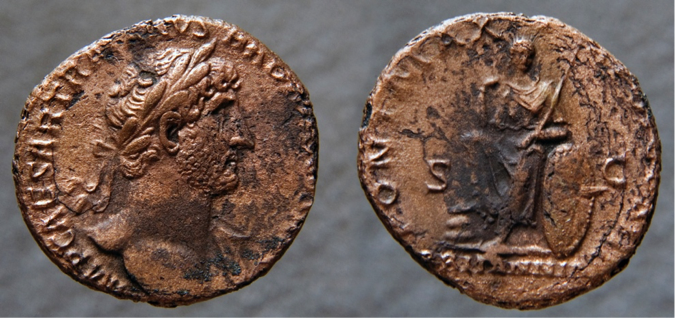
Roman Coin of Hadrian AD 117-138. This is the very first example of Britannia being used on a British coin. Finder and image: Nick Stevens
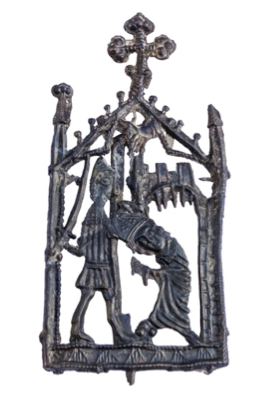
Medieval Pilgrim’s Badge. Depicting the martyrdom of St. Thomas Becket, the Archbishop of Canterbury who had fallen out of favour with King Henry II. Dated to 14-16th centuries. Finder: Tony Thira. Image: PAS
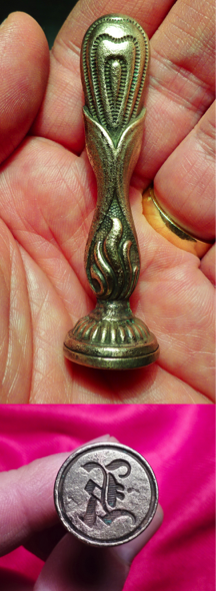
17th century Seal Matrix Used to authenticate documents and letters, they were often engraved with the owner’s initials, family crest or personal emblem.Inscribed with the cursive letter K on the base. At the top of the rounded handle, the dotted outline of a heart is shown emerging from flowing flower petals. Finder: Jason Sandy. Image: Jason Sandy
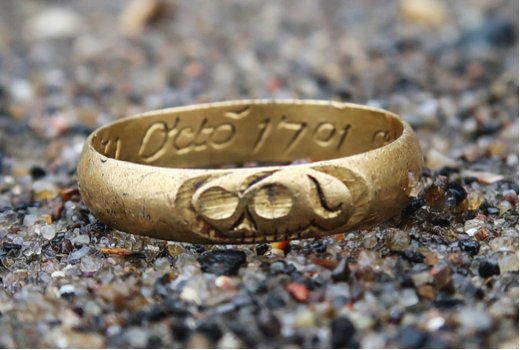
18th century Momento Mori Ring. These types of rings were sometimes given out at funerals to commemorate a deceased person. Often with initials and dates inscribed on the inside, their morbid style was very popular during this time. This memento mori ring is engraved with a skull and was most likely inlaid with black enamel. Finder: Nick Stevens Image: Nick Stevens

Pudding Lane Token 17th century traders token from Pudding Lane (spelt pudin). Pudin was the Medieval term for offal. Slaughterhouses nearby contaminated the lane with blood and entrails. Dated 1657. Finder and Image: Nick Stevens

18th century Prisoners Ball and Chain. Interestingly the lock is closed. Did the prisoner die whilst shackled or perform a miraculous escape? Finders: Steve Brooker and Rick Jones. Image: Rick Jones

Victoria Cross Medal VC medal from an unknown soldier. Issued for an act of valour during the Battle of Inkerman in the Crimean War. Dated 1853. Finder Tobias Neto. Image PAS